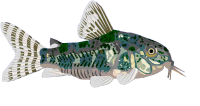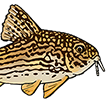Axel Makay Katz, Maria Anais Barbosa, José Leonardo de Oliveira Mattos, Wilson José Eduardo Moreira da Costa. 2018. Multigene analysis of the catfish genus Trichomycterus and description of a new South American trichomycterine genus (Siluriformes, Trichomycteridae). Zoosystematics and Evolution, 94(2):557-566.
Abstract
Trichomycterus comprises about 170 valid species, but its monophyly has been challenged in the last decades. Bayesian Inference and Maximum Likelihood analyses comprehending mitochondrial genes COI and CYTB and nuclear genes GLYT, MYH6 and RAG2 from 71 Trichomycterinae terminal taxa and eight outgroups were performed. The analyses highly supports a clade containing Trichomycterus nigricans, the type species of the genus, and several other congeners endemic to eastern and northeastern Brazil, herein considered as the genus Trichomycterus, the sister clade the southern Brazil and adjacent areas clade; the latter clade comprises two subclades, one comprising species of the genus Scleronema and another comprising species previously placed in Trichomycterus, herein described as a new genus. Cambeva gen. n. is distinguished from all other trichomycterines by the presence of a bony flap on the channel of the maxillo-dentary ligament, the interopercle shorter than the opercle, a deep constriction on the basal portion of the antero-dorsal arm of the quadrate, absence of teeth in the coronoid process of the dentary, the maxilla shorter than the premaxilla, the cranial fontanel extending from the medial posterior of frontal to the medial region of supraoccipital, and absence of the postorbital process of the sphenotic-prootic-pterosphenoid.
(No new species are described, but 25 species of Trichomycterus are definitely, or tentatively, transferred to the new genus. LF)
Open access at:
https://zse.pensoft.net/article/29872/list/5/
Multigene analysis of the catfish genus Trichomycterus and description of a new South American trichomycterine genus
-
lfinley58
- Expert
- Posts: 725
- Joined: 04 Jan 2003, 19:16
- I've donated: $90.00!
- My articles: 3
- My images: 3
- Spotted: 3
- Location 1: Margate
- Location 2: Florida USA
- Interests: Catfishes (all), Aquarium History




